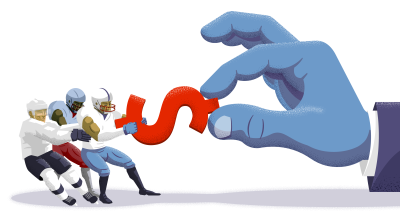Las Vegas soon could learn about work stoppages in pro sports
hen it comes to collective bargaining in pro sports, fair play doesn’t apply.
What matters most is leverage.
Las Vegas might learn firsthand in 2020 how such a tug of war affects the world of major league professional sports, as the city is set to house an NFL franchise in the Raiders along with its NHL team in the Golden Knights
With such truth comes this reality: Fans across Southern Nevada might soon confront the possibility of local teams being embroiled in labor standoffs.
Both football and hockey have daunting tasks ahead to reach common ground and avoid work stoppages. The NFL is on a more inflexible route; its collective bargaining agreement expires following the 2020 season.
The current NHL deal expires after the 2021–22 season, but both the league and players can opt out at different points next month. Baseball’s deal is up in 2021, and there is a growing sentiment that what has been 25 years of labor peace might soon end.
Things are less immediately challenging in the NBA. The current CBA runs through the 2023-24 season, though either side can opt out a year earlier.
It might also be worth keeping an eye on Major League Soccer, where Las Vegas is again seeking to add a franchise. Its CBA expires in January 2020.
“The whole topic of collective bargaining between owners and players is fascinating, because you’re talking about a lot of money and, much like in the entertainment industry, there are no special labor laws for sports,” said Mark Conrad, associate professor of law and ethics and director of the undergraduate sports business concentration at Fordham University’s Gabelli School of Business. “We’re not talking about those who might work in a supermarket or casino and are unionized, where there are laws consistent with all such groups.
“You are talking about elite athletes and putting them in labor negotiations, trying to come to an agreement for a group with a wide range of abilities and salaries. So the NBA player who makes the minimum for his sport is in the same union as LeBron James. How do you handle such disparaging forces and come to a deal where everyone is satisfied?
And, as with all such things, there is vast history to it.

Marvin Miller walked a picket line in a union organizing drive as a young boy. His mother was a member of the New York City teachers union. He graduated from college with a degree in economics. During World War II, he resolved labor-management disputes for the National War Labor Board while also working for the International Association of Machinists and the United Auto Workers.
The man enjoyed a good debate.
“Marvin really understood the relationship between worker and management,” Conrad said. “If anything, he would be disappointed with some of the current CBAs. He would say there hasn’t been enough rights given to players. He would be quite upset that a salary cap system is in place for certain sports, given the power owners have and the money they are making.”
Miller died in 2012 at the age of 95, and almost immediately the sports world began chronicling his profound impact on it, specifically leading baseball players in a series of strikes and legal battles that ultimately turned athletes into multimillionaires.
His influence revolutionized, not only baseball, but all sports, permanently changing the business side of the equation. He viewed rules that bound a player to one team as little more than 20th-century slavery.
It all began with Curt Flood.
The St. Louis Cardinals outfielder became a pivotal face in the sport’s labor history when he refused to accept a trade to the Philadelphia Phillies in 1969.
Instead, he sued Major League Baseball and then-commissioner Bowie Kuhn over the reserve clause — which didn’t allow players under contract to enter a deal with a different team, essentially not allowing for freedom to play elsewhere — but ultimately lost at the Supreme Court in 1972.
Flood’s persistence, despite none of his fellow players or friends coming to his defense, allowed others to bring forth challenges. Miller used arbitration in the following years as a path to what we now know as free agency.
It would be Miller’s lasting legacy and changed sports forever.
“I think it’s fair to say things are much more complex now,” said Steve Fehr, special counsel to the NHL Players’ Association and younger brother of Don Fehr, the NHLPA executive director and former union chief to the Major League Baseball Players Association. “Back when Marvin was negotiating in the 1960s and ’70s and ’80s, much of it was about basic economics. But now you have so many different areas — revenue sharing, salary cap issues, domestic violence, performance enhancing drugs, luxury tax, health and safety, social media … there is a lot more going on.”
Which could directly affect sports fans in Las Vegas very soon.

The Knights are two playoff seasons —including one historical expansion run to a Stanley Cup Final — into their existence. The town has gone bonkers for them. This love affair between city and franchise borders on indescribable, given the infancy of the relationship.
But whether T-Mobile Arena might eventually go dark due to labor unrest is unknown. NHL owners can opt out of the current CBA on Sept. 1. Players can do so Sept. 15.
Either move would begin the countdown to what could be the league’s fifth work stoppage.
A main point of contention: The NHL and its players association annually put a percentage of player salaries in escrow during the season as a mechanism to ensure teams and players achieve a 50-50 split of hockey-related revenue. All of this was collectively bargained.
But players have cooled on the concept. They want a contract to be worth what the ink says, meaning escrow alone could lead to a stoppage.
Things are a bit different in the NFL, which Las Vegas will know much more about when the Raiders arrive at their new home next season. Last month, commissioner Roger Goodell said the league wants a new CBA before the start of the 2019 regular season.
As in, yes, days from now.
“That’s certainly our intent,” Goodell told reporters in July. “We’re continuing dialogue for (that timetable). There are obviously changes we all want on both sides, and I think those are things that’ll improve us and try to make the (CBA) continue to be successful for all the parties, and I hope we’ll do that.”
As of this week, the league and union had engaged in five formal negotiating meetings.
The last thing NFL owners desire is an ugly labor war looming as a marketing campaign focusing on the league’s 100th season hits full throttle — not to mention the impending end of deals with TV rights holders — and yet things are never as easy as both sides claim they would prefer.
So maybe new CBAs are enacted in both leagues and fans in Southern Nevada never know the reality of a local team going on strike or being locked out.
I would tell people this: ‘Imagine if your son is one of those athletes. Do you want a quick resolution where his rights aren’t served or one where his health and financial welfare is taken into account?'
GENE ORZA, FORMER MLB PLAYERS ASSOCIATION EXECUTIVE
And maybe not.
“In the final analysis, it’s about the welfare of the individuals on both sides of the labor aisle,” said Gene Orza, the former MLB Players Association executive who guided players through work stoppages and steroid scandals. “Fans can’t dictate the outcome of negotiations. I would tell people this: ‘Imagine if your son is one of those athletes. Do you want a quick resolution where his rights aren’t served or one where his health and financial welfare is taken into account?’
“No one wants fans to be upset, but those who get mad and scream and yell about a work stoppage and say they’re never going to watch again are the exact ones who will. All that’s telling both sides is that they’re passionate. The smartest thing fans can do in a stoppage is act as if they don’t care. Players will worry about losing that person. The person that throws rocks and rants and raves … You never risk losing them.”
It’s something to think about, Las Vegas.
Welcome to another aspect of major league professional sports.





APA, Calif. — A blitz may be coming, Warren Sapp hears.
The Pro Football Hall of Fame defensive tackle attended a Raiders practice this month when the topic of an expiring collective bargaining agreement was raised. The uncertainty could produce a work stoppage. That means the Raiders’ second Las Vegas season in 2021 may be abridged or, however incredibly improbable, canceled outright.
The leadership of the NFL Players Association has stated publicly it’s preparing for “war” in 2021, when the CBA is set to expire. Active players have been advised to prepare their finances accordingly.
Raiders owner Mark Davis is not allowed to comment on labor negotiations. NFL commissioner Roger Goodell speaks for the owners.
Sapp knows a thing or two about creating pressure. But when it comes to the labor deal, he’s not feeling it.
“This is the goose that lays the golden egg,” said Sapp, who played for the Raiders from 2004 to 2007. “There’s no way you stop this league with a brand new stadium coming in. Right after the 100th year? Come on. Nah, nah. … They’re not going to — no, no, no-no-no. Un-uh. Un-uh. No.”
The NFL is celebrating its 100th anniversary this season.
Next year, in Las Vegas, the Raiders are scheduled to open a $1.9 billion stadium. It will seat 65,000 and provide a long-standing, state-of-the-art home to a historic franchise that has drifted between Oakland and Los Angeles. The club currently shares RingCentral Coliseum with the Oakland Athletics.
Also next year, in Inglewood, California, the Rams and Chargers are due to open their own stadium, a $4.9 billion project whose variable seating will exceed 70,000.
The league continues to command high television ratings. The salary cap has grown by at least $10 million each of the past six years. Fan interest is high, as discussions about contracts, injuries and a certain Raiders wide receiver’s helmet have captivated the country’s greater sports conversation during a supposed offseason.
It’s unclear what would constitute a good time for a work stoppage.
But with all this momentum, 2021 isn’t it.

To that effect, the NFL’s Management Council Executive Committee and the NFL Players Association’s Executive Committee have engaged in a series of meetings this offseason with hopes of finalizing CBA terms before the start of the 2019 season. A resolution before March 2021 would avoid the stoppage for which the NFLPA has braced itself.
It has developed what it calls a “war chest” of hundreds of millions of dollars for reserve savings should a stoppage hit. This would enable players to hold out longer for the results they seek. As another example, the union has withheld recent annual checks that players were due to receive for their likeness being used in the Madden NFL video game franchise.
Should a work stoppage linger, those checks can be dispersed as income.
Despite such prep work, Raiders players don’t seem concerned about a potential stoppage. Several were approached about this topic in recent weeks. None seemed comfortable or, for that matter, especially eager to discuss it.
The 90-man roster doesn’t have a de facto spokesperson on union matters. Tight end Lee Smith, who was released in March, technically still votes as the Raiders’ union rep, a union official said, but Smith resides about 2,300 miles away while working with his new team, the Buffalo Bills.
Don’t not let the goose lay the golden egg. Everybody gets around that golden egg, and there’s no way we’re (going to) leave Vegas high and dry after building that nice stadium.
WARREN SAPP, PRO FOOTBALL HALL OF FAMER & FORMER RAIDERS DEFENSIVE TACKLE
A new rep won’t be voted upon until September.
“I haven’t thought much about it, to be honest,” nickel cornerback Lamarcus Joyner said of a possible work stoppage in 2021. “That’s out of my control. I just wish the guys who are the faces of that battle do a really good job to protect the players and make sure the players get a lot out of it. I haven’t really been paying attention, but when it happens, it happens.”

Details about the current CBA talks are vague.
And deliberately so.
Both sides have privately agreed not to negotiate through the news media. Should discussions reach an ugly impasse, the nature of the disagreement between the NFL owners and the NFLPA seeping into the public would be consistent with past episodes. They aren’t there yet.
It’s fair to expect certain issues to be addressed in the next CBA.
The league’s stance on marijuana use is expected to be softened. Players hope to revise how the commissioner handles discipline on that and other issues, though that fight could be more difficult. Certain protections are mutually desired to protect player and league interests amid the increased prevalence of gambling.
The NFL long has flirted with expanding the regular-season schedule from 16 to 18 games. This would increase league revenue, but players are not expected to back it. DeMaurice Smith, the NFLPA’s executive director, has spoken against that proposal, which would limit the number of games in which any given player could participate to the current 16.

After a January news conference in Atlanta, NFLPA president Eric Winston was asked what the most contentious issue will be in negotiations.
His answer: “All of it.”
“Listen, I don’t mean to be flippant about it,” Winston added. “You might have a pet issue. He might have a pet issue. Players have certain issues. But this is a comprehensive deal. The CBA is (considerably) thick. I don’t have the luxury of, ‘Well, this is going to be the most battled one, so I’m going to be really invested in this or not invested in that.’ I’m investing in all of them, and it’s going to take that global solution to figure this out.
“If we can’t agree on something here, then maybe we can take from something over there to edge us a little closer. Obviously, money always is going to be. We want 99.9 perent. (Owners) want us to take 0.1 percent. Where do we meet on that? Where do we meet on player restriction issues? Free agency issues? Offseason issues? Where do we meet on all of those things? Again, there’s not a level of ‘Oh, one is much more contentious than the other.’ … They look at the world a certain way, and we look at the world a certain way. We’ve got to figure out how to (build) those bridges to figure that out.”
Recent attempts to reach Smith and Winston weren’t successful.
Sapp predicts the negotiations will succeed.
“We go in there with DeMaurice, and DeMaurice has to fight for it,” Sapp said of a fair deal before a 2021 work stoppage. “A couple dudes are going to yell something, and (we’ll) see if we can just bend it and mold it and keep getting (the deal) better because that’s all you can do. Just keep bending and molding. That’s it. “
“Don’t not let the goose lay the golden egg. Everybody gets around that golden egg, and there’s no way we’re (going to) leave Vegas high and dry after building that nice stadium.”

ny NFL coach will tell you defense wins championships,
The gaming industry seemingly agrees, having found a way to defend itself from sharing revenue generated by the expansion of sports wagering.
Whether it’s called an “integrity fee,” a “royalty,” “official data” or, now, a “processing fee,”the industry has managed to block professional sports leagues’ attempts to gain a share of revenue generated by gaming at a time when the industry is rapidly expanding outside Nevada.
The Supreme Court’s 6-3 ruling on May 14, 2018, in Murphy v. National Collegiate Athletic Association determined that the 1992 Professional and Amateur Sports Protection Act was unconstitutional. In essence, that meant states across the nation could join Nevada in allowing sports wagering.
Immediately after the decision was announced, several state legislatures went to work adopting sports betting regulations. This month Iowa became the 11th state to offer legalized sports wagering.
The leagues lobbied for a cut of the action — and failed.

While gaming revenue is expected to add some money to leagues and teams, it isn’t likely to be enough to move the needle when it comes to drafting new collective bargaining agreements that could prevent work stoppages for the NFL after the 2020 season and the NHL after the 2021-22 campaign.
Teams saw gaming revenue as a potential financial savior, but they failed to understand the tight margins with which sportsbooks operate. Leagues expected they would be able to tap a pool of billions of dollars, apparently not realizing most of that money is generated as handle — the amount bet by gamblers — and most is returned to winning bettors, with small-percentage cuts going to taxes and the sportsbook itself.
Former Nevada Gaming Control Board Chairwoman Becky Harris, now an academic fellow with an emphasis on the study of sports wagering at UNLV’s International Center for Gaming Regulation, has written extensively on teams and leagues attempting to capitalize on sports gaming’s expansion. She explained the disconnect on the revenue and expenses of a typical sportsbook.
In a paper explaining sportsbook finances, Harris wrote, “Operating on thin margins (5 percent or less), navigating volatile revenues (the unpredictability of game outcomes) and a constant need to be competitive, race books and sports pools have almost as much on the line as the bettors do.”

As an example, Harris prepared a series of charts showing Super Bowl handle, how much bettors won, how much would be collected under Nevada’s 6.75 percent tax rate and the amounts teams or leagues would collect with a fee of 2 percent, 1 percent or 0.25 percent for games played between 1991 and 2018.
Super Bowl XLVIII, in which the Seattle Seahawks beat the Denver Broncos 43-8 at Metlife Stadium in New Jersey in 2014, was profitable for Nevada books. Gamblers wagered $119.4 million — the first time the Super Bowl generated a nine-figure handle — and won $19.7 million. The state receiving $1.3 million based on a tax on the book’s win. Had the NFL received a 2 percent cut of the handle, it would have gotten $2.4 million.
A 1 percent cut would have yielded $1.2 million, and a 0.25 percent cut would have yielded $298,502.
But consider Super Bowl XLII, when the New York Giants upset the New England Patriots 17-14 in Glendale, Arizona, in 2008. The handle was $92.1 million, and books lost $2.6 million. The NFL would have received $1.8 million from a 2 percent fee, $920,558 from a 1 percent fee or $230,140 from a 0.25 percent fee. The books would have lost even more, and the state wouldn’t have collected any tax revenue.
“That’s the disconnect that’s going on with fees that are proposed,” Harris said. “You have the state and the taxpayers taking a significantly reduced amount.”
Harris said teams and leagues could run into another roadblock if they want to take gaming profits — they’d have to be licensed.
“When you start talking about a share in wagering, I think that complicates the conversation because (Nevada law) states that … it is unlawful for any person as owner, lessee or employee to partake in a share of gross gaming revenue,” she said. “So my concern is that, by their continuing to share an amount wagered, they might trigger state regulatory licensing requirements and find themselves subject to the jurisdiction of gaming regulators.”
Gaming industry analyst Chris Grove, a managing director at Eilers & Krejcik Gaming, doesn’t expect teams or leagues to take a path that would require them to be licensed.
“They’ll just partner with a licensed company,” he said. “They’re not in the business of grilling hamburgers, even though they sell them.They’re not in not in the business of stitching uniforms, even though they will accept your credit card in exchange for one.”

That’s why teams and leagues are partnering with established gaming companies.
“From the gambling side, I’m not sure that we’re at the point yet where you’re really going to see sports betting deliver any kind of material revenue to the leagues or the players,” Grove said. “The bulk of the revenue that you’re likely to see move in that direction over the next few years will be largely marketing partnerships. That may bring benefits to some individual players, especially former players, to some individual teams, but in terms of an economic windfall for the league as a whole, I think we’re still several years out from that point.”
They’ll just partner with a licensed company. They’re not in the business of grilling hamburgers even though they sell them. They’re not in not in the business of stitching uniforms even though they will accept your credit card in exchange for one.
CHRIS GROVE, GAMING INDUSTRY ANALYST
Joe Asher, CEO of William Hill US, concurs.
“It’s very early in the game,” said Asher, whose company has signed deals with the New Jersey Devils and the Golden Knights. “We went from not having any opportunity to do business together because the leagues historically have been opposed to sports betting. Now that it’s legal, there’s been a change of heart, and we’re looking for ways to figure out how to benefit.”
Asher said the biggest surprise for him is how quickly and aggressively teams and leagues have embraced sports betting now that it’s becoming more mainstream.
“It wasn’t that long ago when the commissioners of these leagues were testifying how terrible it would be if sports betting was going to be legalized and they were fighting the court case like everything depended on it,” he said. “Now the Supreme Court ruled and settled the issue, and it’s fascinating to see how quickly they changed. Obviously, (NHL commissioner) Gary Bettman was pretty clear about this. ‘Why have your views on sports betting changed?’ He said, ‘Two words: Supreme Court.’ ”

he Golden Knights have been a runaway success story their first two seasons in the NHL, but a stop sign may be on the horizon.
The collective bargaining agreement between NHL owners and the NHL Players’ Association is set to expire after the 2021-22 season, but negotiations for a new deal are about to commence. Such talks haven’t gone well in recent history. The haggling over the last three CBAs in 1994-95, 2004-05 and 2012-13 was contentious, ugly and ultimately led to the cancellation of 2,182 games.
Things appear to be starting on a more harmonious note this time around, though, as deadlines approach for an early termination of the CBA. The NHL can decide Sept. 1 if it wants the CBA to end early, on Sept. 15, 2020. The NHLPA can do the same Sept. 15.
The different tune is thanks to rising franchise valuations, soaring salaries and added job opportunities because of the Knights and a Seattle franchise that will begin play in 2021.
The NHL is in a healthy place, and no one wants to put that stop sign up. But there are issues to resolve.
“No one wants to see a lockout,” said Knights defenseman Nate Schmidt, the team’s NHLPA representative. “I know our guys don’t want to see a lockout. The owners definitely don’t want to see a lockout. You lose fans that way. It’s in nobody’s best interest to lose games. But are there some things that our guys would want to sink their feet in? Yeah, I think there could be. But I don’t think either side wants to do that.”

That alignment depends on, as Schmidt said, “logistical money issues.”
The two sides are discussing things like international hockey participation, alterations to the pension plan and long-term health benefits, but the focus is on money. One specific thing being addressed: escrow.
In the last round of negotiations, owners increased their share of the league’s hockey-related revenue (ticket sales, broadcast rights fees, etc.) to 50 percent. Players are entitled to the other 50 percent, but arriving at that exact split is difficult.
The typical pro athlete is earning a lot of money real quick but then it ends real fast and if you’re not prepared for it ... it can hit you pretty fast.
CHRIS MOYNES, FINANCIAL ADVISOR
To ensure it happens, a portion of each player’s salary is withheld from his bimonthly paycheck and gets put in an escrow fund. If, at the end of the year, the owners haven’t received their full slice of the pie, they dip into the escrow fund to make up the difference and give the players back whatever money they didn’t use.
Financial adviser Chris Moynes, who has over 100 NHL clients as the managing director of ONE Sports + Entertainment Group, said on average players have lost 12.5 percent of their pay via escrow during the current CBA.
That means Schmidt, who is set to make $6 million this upcoming season, should expect to lose $750,000 in escrow payments. That’s a significant amount for him and other professional hockey players when the average career lasts just five years.
“This money has to last so much longer than it does for you and I because of their earning potential,” Moynes said. “The typical pro athlete is earning a lot of money real quick, but then it ends real fast, and if you’re not prepared for it, be it from a savings perspective or being ready to do something next, it can hit you pretty fast.”

Schmidt said the players have had “preliminary” discussions about what they would like to see changed, but they haven’t created a formal proposal yet.
When they do, NHLPA executive director Donald Fehr will lead negotiations with the league.
Fehr has always been ready for a fight in talks. Before taking his current job in 2010, he was the head of the Major League Baseball Players Association from 1985-2009. In that job he took part in two labor disputes: the 32-day lockout in 1990 and the 232-day strike of 1994-95 that resulted in the World Series not being played for the first time since 1904.
The NHLPA turned to him after giving major concessions after the 2004-05 work stoppage. He led them through the 2012-13 lockout.
Fehr’s special assistant at the NHLPA, Mathieu Schneider, described the tone of talks as more positive during All-Star Weekend in January, but things could change once proposals are exchanged.
“We’ve had several bargaining discussions with the league and have future meetings planned,” NHLPA spokesman Jonathan Weatherdon said in a statement to the Las Vegas Review-Journal. “The owners will be making their re-opener decision on or before Sept. 1st. If they don’t elect to re-open, we have two weeks to continue discussing further with the players whether or not to exercise our option of early CBA termination in September 2020.”
For its part, the NHL is also sounding more upbeat as more advanced discussions near.
Commissioner Gary Bettman, who has overseen three CBA negotiations and three work stoppages since taking his post in 1993, has repeatedly stressed the league isn’t “looking for a fight.”
Deputy commissioner Bill Daly echoed those thoughts in an email to the Review-Journal.
“I would characterize our discussions to date as constructive and the atmosphere positive,” Daly said. “But we are still a ways away from being able to say whether we will be successful.”
Many will believe it when they see it when it comes to Bettman, who won major concessions after the 2004-05 stoppage and the 2012-13 lockout. There is reason to believe things may be different this time around, though, and it comes down to the almighty dollar.

The NHL is putting on an agreeable face simply because it wants to keep its gravy train rolling. And the amount of money at stake may be enough to force two previously warring parties to work together.
Before the last lockout, Forbes said the average NHL team was worth $240 million in 2011. By December 2018 that average had climbed to $630 million.
The players are also seeing their values rise, because the league’s salary cap has climbed higher and higher under the current CBA. The NHL’s lower and upper limits for team salaries were set at $48.3 million and $64.3 million in 2011-12. They will be $60.2 million and $81.5 million this upcoming season.
“No one’s not doing well,” Schmidt said.
There’s no reason to think those numbers won’t keep increasing with the Seattle franchise and a new national U.S. television deal on the horizon. The NHL’s contract with NBC, which is worth $200 million annually, expires in the 2021 offseason.
Lee Berke, whose LHB Sports, Entertainment & Media advises more than 30 professional and amateur teams, said the league’s next national TV deal could be worth double that — or more.
“The NHL has room to grow,” Berke said. “I think they’re coming into a strong marketplace.”

All that money at stake won’t stop the players from asking for changes when more formal negotiations get underway, but talks appear to be starting on the right note.
If they break down at any point the September opt-outs are in place, but it’s unclear whether either side will exercise them. What is clear is that both sides appear willing to put the ugliness of the past three negotiations behind them to keep the NHL’s salad days going.
“The next couple weeks are where we figure out what’s going to happen,” Schmidt said. “How dug in the players want to be and how dug in the owners want to be on some issues. There’s some things, from our standpoint, that we need to have altered so it helps benefit long-term player health and things like that.”

o know what life would be like in Las Vegas during a pro sports work stoppage, we can look far north toward Buffalo, New York.
That’s where Nellie Drew lives. She remembers some of the labor actions in professional sports that killed Sunday afternoons in her hometown.
“There have been studies done about the importance of professional sports to a community,” said Drew, director of the University of Buffalo’s Center for the Advancement of Sport. “Most often, it’s been in reference to Los Angeles and why the NFL wasn’t successful
there for a long period of time. On Sunday afternoons, there are a whole bunch of other things to do in L.A. besides going to a football game and, oh, by the way, you might well prefer to be at the beach.”
But it’s different in Buffalo.
“Buffalo is a great town, and there are lots of things to do, but the big thing in town is always the Bills and the Sabres,” she said. “You can shoot a cannonball down some of our main thoroughfares on Sunday game days. During the playoffs, forget it.”
The Strip likely would be hopping during Raiders games, as it is during Golden Knights games. But how badly would Las Vegas be hurt if NFL or NHL players walked off the job?
Jeremy Aguero, an economist with Las Vegas-based Applied Analysis, believes the impact would be material because fans who attend Golden Knights games and who are expected to attend Raiders games in 2020 aren’t just from Southern Nevada.
“Every game that isn’t played by the Golden Knights or the Raiders will mean travel activity that wouldn’t happen,” Aguero said. “It would mean fewer heads in beds on the Las Vegas Strip and it would mean less spending.”

Imagine, then, what things were like in Buffalo in 1982 when NFL players walked out for 57 days and the 16-game schedule was reduced to nine, or in 1987, when a 24-day stoppage resulted in two games played with replacement players — a bunch of guys few people had heard of running around in the team uniforms fans had grown to love.
In hockey-crazy Buffalo, missing the Sabres was even worse.
Drew’s doctoral thesis was about “Dispute Resolution in the NHL.” She worked for a law firm that did business with the Sabres before she became a professor. She endured a 10-day players’ strike near the end of the 1992 season, a 104-day lockout in 1994-95, a season-long lockout in which no Stanley Cup was presented in 2005 and a half-season lockout in 2014-15.
While players and owners tangled over revenue sharing, luxury taxes and salary caps, fans dealt with no hockey for months at a time.
Look at St. Louis right now with an empty stadium just sitting there. ... [There's an] undeniable impact of being perceived as a first-rate, big-league town when you have a team.
NELLIE DREW, UNIVERSITY OF BUFFALO CENTER FOR THE ADVANCEMENT OF SPORT
Drew said while cities frequently see dips in the economy associated with sports work stoppages, there’s also a level of psychological damage because fans view their teams as their representatives in a competitive landscape.
There’s a level of pride attached to having a representative in the big leagues and a level of despair if that team goes away temporarily or permanently. Drew said one need only look at St. Louis as an example of a city that has had its NFL teams ripped away from it twice. It lost the Cardinals to Phoenix in 1988 and the Rams to Los Angeles in 1995.
“You can certainly identify definite economic benefits and significant ones for having a professional sports franchise in your city as opposed to not,” she said. “If you want any evidence, look at St. Louis right now with an empty stadium just sitting there. There’s also some beyond the obvious, the restaurant business and the hotel business. There’s also the undeniable impact of being perceived as a first-rate, big-league town when you have a team.”

Aguero said it’s been documented in studies conducted by the Las Vegas Convention and Visitors Authority that the average visitor to Las Vegas spends about $800 per trip. As a result, any loss of activity would mean a loss of spending and the tax revenue that goes with it.
“It can have ripple effects on wages and jobs, everything from tips to paychecks, and if it’s significant enough, it could mean a reduction in workforce as a result of less activity,” he said.
Representatives of the LVCVA declined comment on the potential impact on the tourism industry of a work stoppage by NFL players, whose collective bargaining agreement is up for renewal around the time the Raiders move into Allegiant Stadium next year, or the NHL players and owners, who can opt out of their existing agreement as early as next month. The LVCVA is in negotiations to host next year’s NFL draft, and the community embraced the Knights when the team helped lift the city after the Route 91 Harvest festival shooting in 2017.
Aguero said estimating a loss in activity also reflects what an economic boon professional sports franchises can be.
“We would suffer an economic loss because of the remarkable economic benefit of actually having them in the community,” he said. “All the games that are played, all the travel decisions that are actually made, all the hotel rooms that are filled is because somebody comes to Las Vegas from Winnipeg because their team is playing the Golden Knights or because somebody comes from Buffalo because the Bills are playing the Raiders.”
“Yes, there is going to be the risk of interruption from time to time from unforeseen circumstances — any unforeseen circumstances. But even those interruptions and the impacts associated with them is merely a reflection of the benefits that are actually drawn from the activity in the first place.”
Las Vegas is more susceptible to stoppages because it is so reliant on tourism and the service industry that supports it.

Aguero was called upon to analyze the economic impact of the development of the 65,000-seat, $1.9 billion stadium being built by the Raiders when the Southern Nevada Tourism Infrastructure Committee was studying the issue in 2015 and 2016.
At the time, he estimated an annual recurring economic impact through direct, indirect and induced output of $620 million, payrolls totalling $231 million a year and the provision of 5,982 jobs. The stadium construction alone was expected to produce $2.8 billion in output, $968 million in total wages and employment of 18,711.
Those are calculated by totaling jobs, wages and output directly from the stadium and suppliers. That includes labor associated with projects that might not be based in Southern Nevada.

Aguero said he’s been astonished at how the Knights have been able to fill hotel rooms, particularly at New York-New York, adjacent to T-Mobile Arena.
“The number of activations they have done, the number of people that stay in that hotel, some of whom don’t even go to the games, is just amazing to me,” he said. “The number of people who come from all over the country and then from all over Canada to come to Vegas, to follow their teams, to make a weekend out of it when their team is playing on a Thursday and they stay though Sunday and just have a great time in Vegas while they’re here.”
Representatives of MGM Resorts International, which stands to benefit the most because of its properties’ proximity to T-Mobile and Allegiant Stadium, declined to comment on how the Knights have helped the company or how much they anticipate the Raiders will add.
“You would be amazed at how many people come to Las Vegas or come with someone who goes to the event and they come as a party of five, and two people go to the event. The other three came because the other ones were coming to Vegas but didn’t actually go to the event itself,” Aguero said. “It’s a remarkable number of people. That’s what makes Vegas great. That’s what makes Vegas incredible is that somebody would come for that special event, even if they don’t go. There’s so many things to do while they’re in town.”
The big question is whether they’d still come if players weren’t on the field or the ice.
Contact columnist Ed Graney at egraney@reviewjournal.com or 702-383-4618. He can be heard on “The Press Box,” ESPN Radio 100.9 FM and 1100 AM, from 7 a.m. to 10 a.m. Monday through Friday. Follow @edgraney on Twitter. Contact reporter Michael Gehlken at mgehlken@reviewjournal.com. Follow @GehlkenNFL on Twitter. Contact Richard N. Velotta at rvelotta@reviewjournal.com or 702-477-3893. Follow @RickVelotta on Twitter. Contact Ben Gotz at bgotz@reviewjournal.com. Follow @BenSGotz on Twitter. Contact David Schoen at dschoen@reviewjournal.com or 702-387-5203. Follow @DavidSchoenLVRJ on Twitter.













